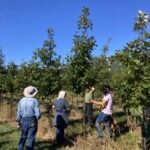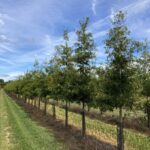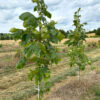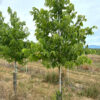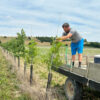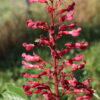Quercus rubra, the northern red oak, is one of the most important timber trees of eastern North America. Its native range extends from the Canadian Maritimes west across Ontario to Minnesota and southward to Arkansas, the southern Appalachians and North Carolina. It is the namesake of the red oak group, characterized by acorns that take two seasons to mature and generally having toothed rather than rounded leaf lobes. Among native oaks, it is one of the fastest growing in youth. It inhabits a variety of environments but prefers rich and slightly acid soil and in less common on rocky, shaly ground.
Red oak as a young tree is rather coarse, gradually forming a rounded to slightly pyramidal crown when given ample room. As the tree matures, it loses lower branches, evolving into a massive, open-crowned tree devoid of branches for up to 30-50 feet above ground. In the wild, specimens can reach 120 to 140 feet in height, but typically only 75 feet under landscape conditions. The massive trunk of a mature tree is a deep brown, broken with wide, flat, somewhat shiny, grey ridges. Leaves open a fuzzy, pink-tinged white becoming smooth and dark green with shallowly-toothed bristly lobes. The fall color is usually a deep red fading to light brown before dropping. Unlike most natives, the leaf cycle of the red oak is controlled strictly by light and not dependent upon temperature. Leaves begin to emerge when the length of daylight exceeds thirteen hours; they begin to shut down once daylight drops below 11 hours. The yellow-green catkins emerge at the same time as the leaves, and soon give way to clusters of small green acorns which overwinter on the tree, ripening and falling late in their second summer. The acorns are generally as wide as long with shallow cups–and are highly tannic; nevertheless, they are readily consumed by squirrels and deer.
[Article continues below photos.]
In the landscape, Quercus rubra is among the more easily transplanted oaks and tends to establish quickly. It demonstrates a good tolerance for urban environments and recent research indicates the tree is also highly resistant to heat stress. As with many oaks, red oak is the host of several life-threatening fungal diseases, but maintaining a healthy vigorous tree helps to fight infection. Its strong branching helps to maintain structural integrity in wind and ice storms.
As noted, red oak is highly valued as a timber tree. The strong, reddish-brown wood is durable and extensively used for flooring, furniture, and cabinetry. The relatively porous seasoned grain readily accepts stain, preservatives, and other finishes. This porous grain makes red oak wood unusable as barrel staves to mature wines and whiskies, unlike its close-grained white oak relatives.
White House Natives supplies Quercus rubra in 2” and 2½” sizes. It is a versatile native specimen that provides deep shade and year-round interest while readily adapting to numerous landscape situations.


